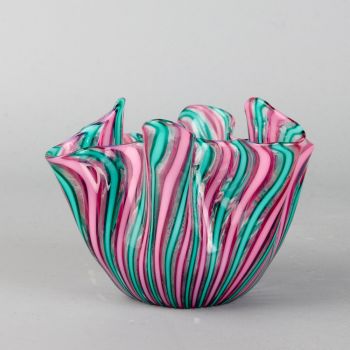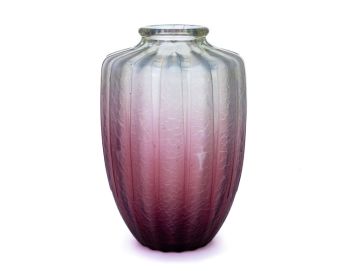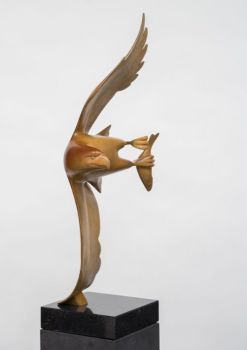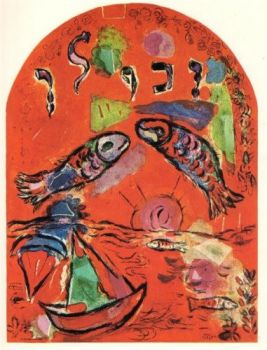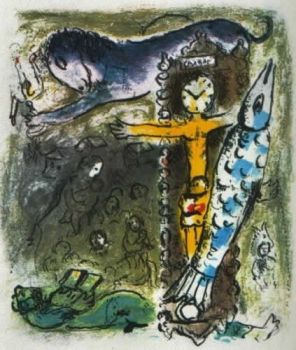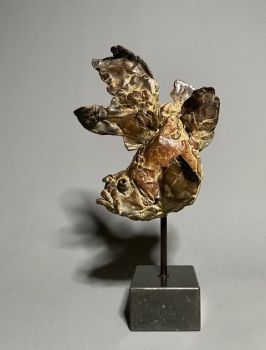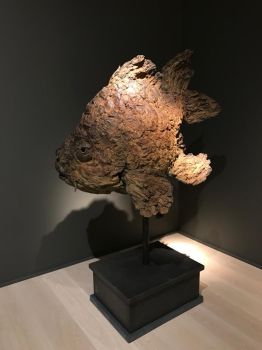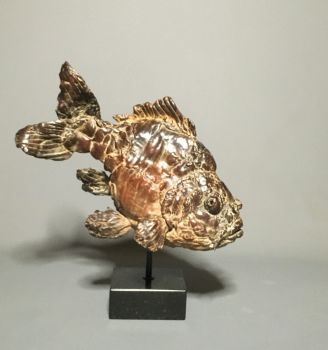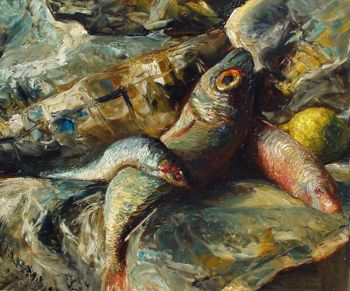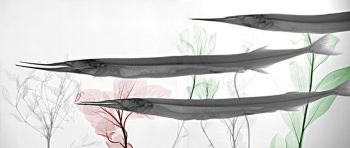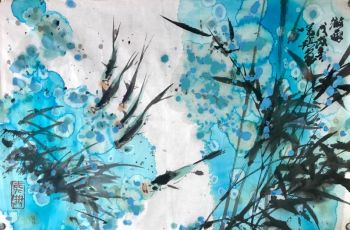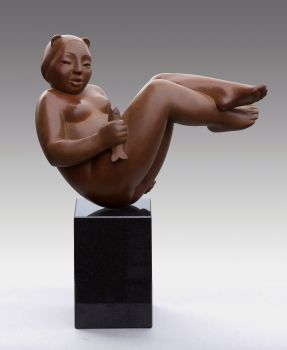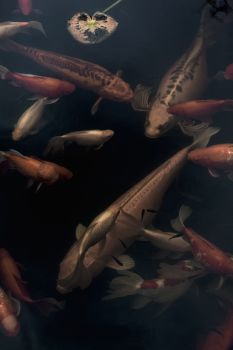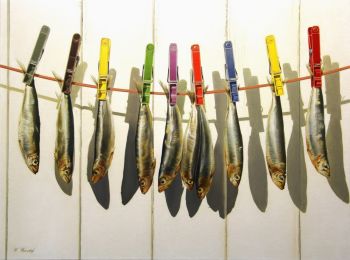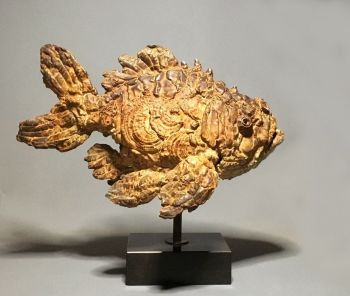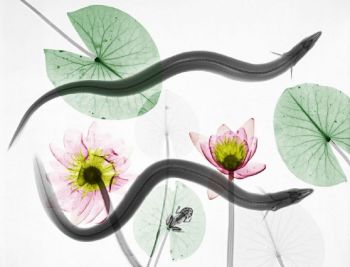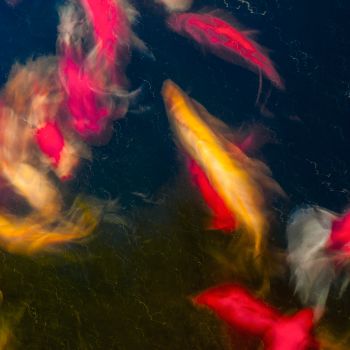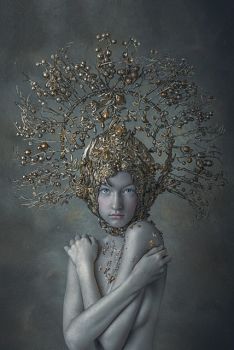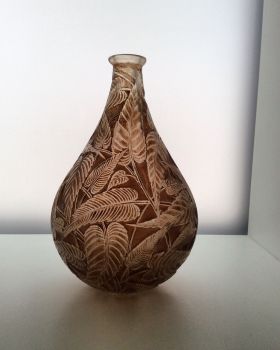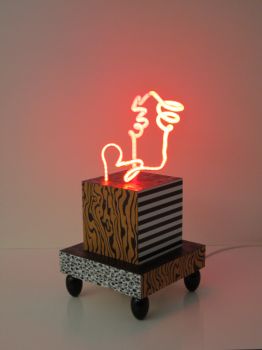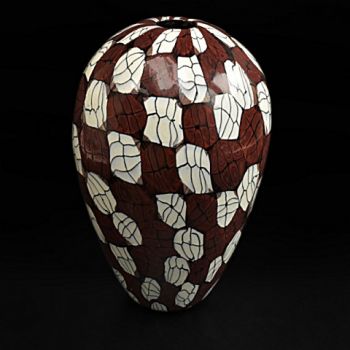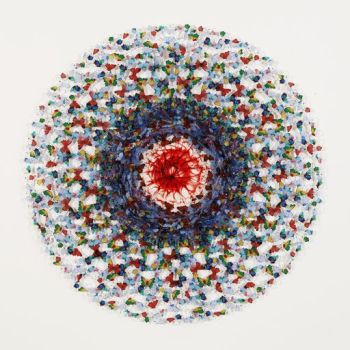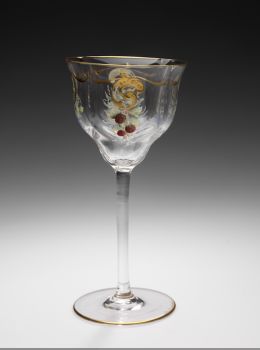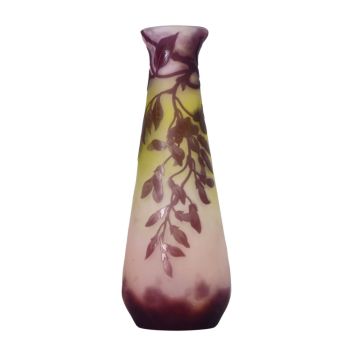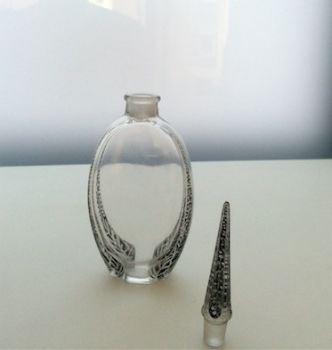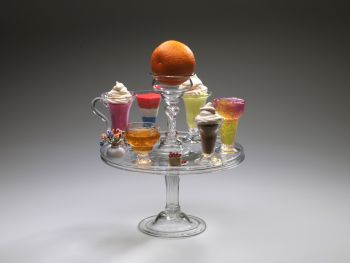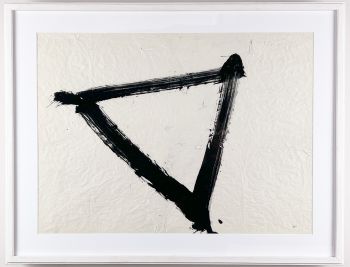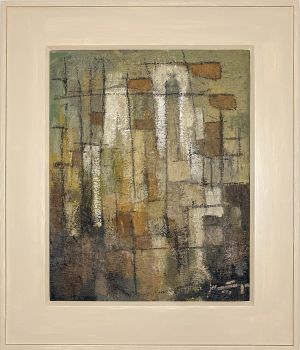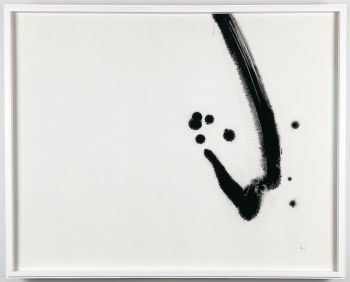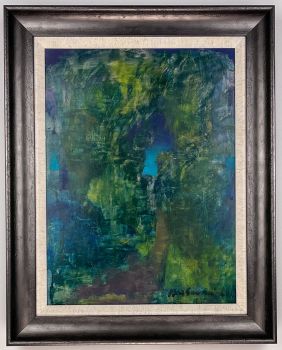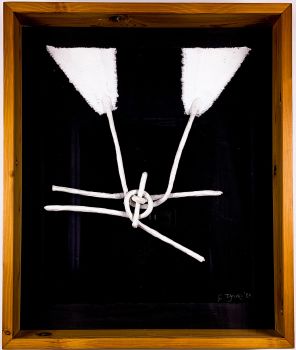A glass art-object “Ruutana” or "Crucian Carp", model KF 226 – Nuutajärvi-Notsjö Finland 1961
Kaj Franck
Glas
9 ⨯ 21 ⨯ 6 cm
ConditionVery good
€ 2.850
Van Kerkhoff Art
- Über KunstwerkAn art-object in the shape of a fish (‘Ruutana’ or Crucian Carp), made of green lead glass with tin crush bubbles. Free-blown with ground and polished base, stylised flattened ovoid body with shaped tail.
This “Ruutana” is model KF 226 in the series of art-objects designed by Kaj Franck. It was produced between 1954 and 1962 by the Nuutajärvi-Notsjö glassworks, winning the Diplôme d’Honneur at the Milan Triennale in 1954. It is a stylised lifesize version of the Crucian Carp, a species widespread across Northern-Europe as far as the Arctic circle in Scandinavia.
The object is signed fully underneath the base: Kaj Franck – Nuutajärvi-Notsjö 61 (1961) and is in very good condition.
About Kaj Franck
Kaj Franck (Vyborg, Finland 1911 – Santorini, Greece 1989), a pioneering Finnish designer and a prominent figure in the Finnish art world from 1940 to 1980, left an indelible mark on the design landscape. Today, his name is synonymous with excellence and innovation, as exemplified by the prestigious “The Kaj Franck Design Prize,” which is annually awarded by the esteemed Finnish Design Forum.
Born in 1911 on the Finnish-Russian border into a family with a rich architectural heritage, Franck had design in his blood. His grandfather held a prominent position as the director of the renowned Arabia Ceramics factory, underscoring the influence and inspiration that surrounded him from an early age.
Franck pursued his passion for design by studying at the furniture department of Taideteollinen korkeakoulu, known today as the Aalto University School of Arts, Design, and Architecture, in Helsinki. Equipped with a solid foundation in design principles, he embarked on a career as a freelance designer before joining Arabia in 1945. It was during his time at Arabia that Franck’s talent truly flourished, and in 1950, he assumed the role of the company’s Artistic Director.
While his contributions to Arabia were significant, Franck’s creative vision extended beyond ceramics. He also designed glass objects for Iittala between 1946 and 1950, and later for Nuutajärvi-Notsjö glassworks from 1950 to 1976. His designs, particularly in everyday tableware and glassware, propelled him to the forefront of the design world. Notably, his iconic Kilta tableware and Kartio glassware are celebrated as revolutionary and enduring symbols of classic Finnish design.
Franck’s design philosophy embodied a profound commitment to principles of moderation, ecology, and equality. Often referred to as “the conscience of Finnish design,” he advocated for minimalism and the conscious reduction of everyday objects, emphasizing the importance of sustainability and product life cycles. Franck’s designs were a testament to his belief that beauty and functionality could coexist harmoniously, enhancing the lives of individuals while respecting the environment.
Recognized for his exceptional contributions, Franck’s works grace the collections of esteemed museums worldwide. Noteworthy institutions such as the Design Museum Helsinki, the Museum of Modern Art in New York, the Stedelijk Museum Amsterdam, and The British Museum in London all proudly display his creations. Throughout his illustrious career, Franck received numerous accolades, including the prestigious Lunning Prize in 1955, as well as “Grand Prix” and multiple “Gold Medals” at the renowned Triennale di Milano.
Kaj Franck’s enduring legacy rests not only on his remarkable designs but also on his unwavering commitment to advancing the field of design. His vision, which emphasized sustainability, simplicity, and social consciousness, continues to inspire designers and enthusiasts alike, ensuring that his influence will be felt for generations to come.
Marked
Signed underneath the base: K. Franck Nuutajärvi-Notsjö '61 (1961)
Execution
Nuutajärvi-Notsjö glassworks, Finland 1961
Condition
This Ruutana is in good condition. Some light scratches and wear consistent with age and use. No chips or cracks.
Literature
Marianne Aav (ed.), Kaj Franck, Universal Forms, p.323
Dimensions
Height 9,8 cm
Width 21 cm
Depth 6,2 cm - Über Künstler
Der finnische Keramik- und Glasdesigner Kaj Franck (1911-1989) hat in seiner herausragenden Karriere eine starke Wahrheit erkannt: Einfach ist schön. Obwohl sich die Welt von einem Jahrzehnt zum anderen immer schneller bewegt, bleibt diese einfache Wahrheit bestehen. Francks Inspiration und Prinzipien begründeten eine Tradition im finnischen Design, die bis heute lebendig und stark ist. Seine bekanntesten Werke sind die Serien Iittala Teema und Kartio, und sein Erbe ist Teil jedes finnischen Zuhauses.
„Ich möchte Objekte verwenden, die so offensichtlich sind, dass sie nicht auffallen“, definierte Kaj Franck seine eigene Arbeit. Seine Entwürfe bedienten grundlegende menschliche Bedürfnisse und dienten ihnen gleichzeitig als Werkzeuge mit Eigenschaften von Alltagsgegenständen. kostenintensive Massenproduktion und gescheuter Materialismus, Wegwerfkultur und Angeberei. Francks Welt bestand aus den mathematischen Grundformen und einfachen Formen, die nur mit kräftigen Farben geschmückt waren.
Der Ausgangspunkt von Francks Arbeit war die Verbindung von Zweckmäßigkeit und Schönheit. Obwohl es heute selbstverständlich erscheint, waren seine Gedanken zu seiner Zeit radikal. Franck hat Stile und Modetrends von der Tradition getrennt und ihr eine ganz neue Bedeutung gegeben. In der Zeit von 1952-53 zeigte Franck mit der Veröffentlichung der Kilta-Serie als starkes Statement, dass Geschirr nicht übermäßig komplex sein muss – es war eine neuartige Idee, dass jeder den Tisch nach seinen eigenen Bedürfnissen decken konnte .
Franck begann seine Designs, indem er sich auf die Idee oder das zugrunde liegende Konzept konzentrierte, nicht auf die Form. Diese Betonung des ideellen Aspekts des Designs wurde auch auf seine Arbeit als Lehrer und später als künstlerischer Leiter an der Universität für Kunst und Design in Helsinki übertragen. Franck war auch einer der ersten Befürworter des Recyclings und wurde oft als „Gewissen des finnischen Designs" bezeichnet. Franck gewann in seiner herausragenden Karriere viele Preise und wurde international bekannt. Heute ist der Kaj Franck Award Finnlands renommierteste Designauszeichnung .
Sind Sie daran interessiert, dieses Kunstwerk zu kaufen?
Artwork details
Related artworks
- 1 - 4 / 10
- 1 - 4 / 24
Unbekannter Künstler
François-Théodore Legras – Tall “Fleurs de Pommier” apple blossoms vase1900 - 1909
Preis auf AnfrageAntiques Emporium
Amalric Walter
Amalric Walter & Henri Bergé – Crabe plumier1920 - 1929
Preis auf AnfrageAntiques Emporium
Johann Loetz (Lötz) Witwe Klostermühle
Johann Loetz Witwe – Ausfuehrung 146 Titania vase – 19121910 - 1919
Preis auf AnfrageAntiques Emporium
Frères Daum
Daum Nancy – “Paysage Soleil Couchant” vase with two applied handles1900 - 1910
Preis auf AnfrageAntiques Emporium
1 - 4 / 24- 1 - 4 / 24
Unbekannter Künstler
Ein seltenes Filigrana, ein Retortoli-Becher1550 - 1600
Preis auf AnfragePeter Korf de Gidts - Antiquairs
Unbekannter Künstler
Salver oder Tazza mit Orangenglas, Gelee und Puddinggläsern.1750 - 1755
Preis auf AnfragePeter Korf de Gidts - Antiquairs
1 - 4 / 24- 1 - 4 / 12






































